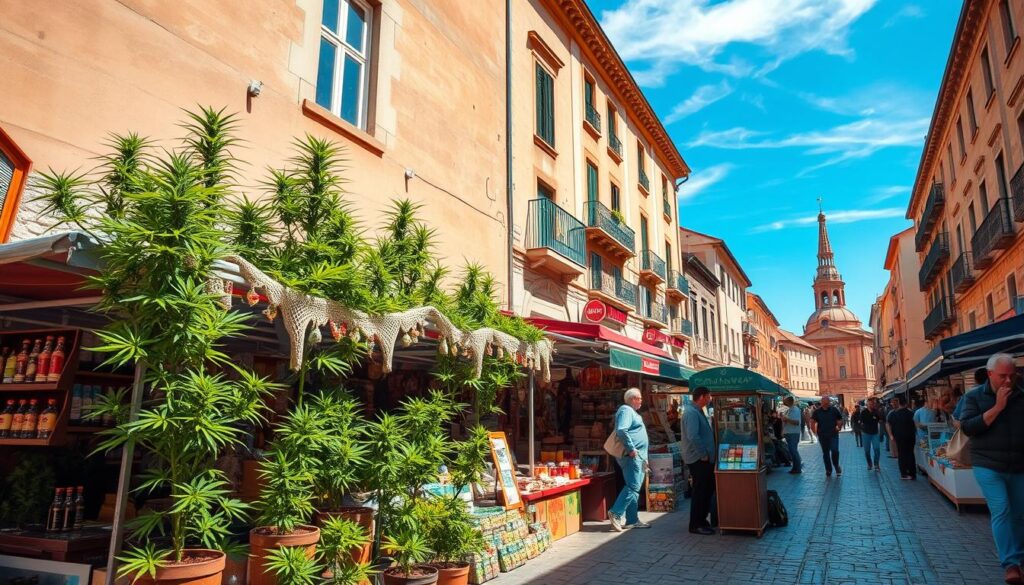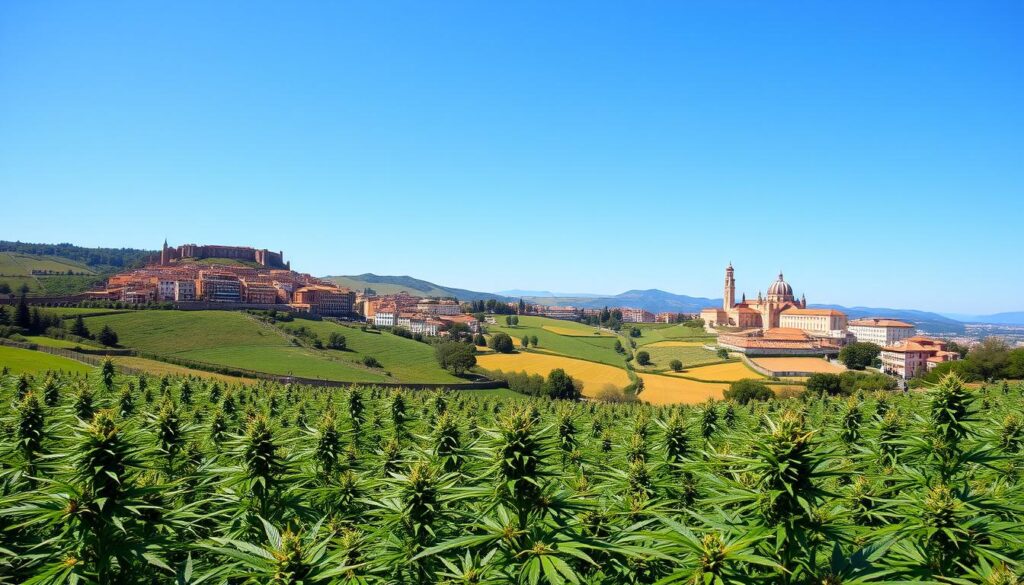Welcome to Lleida, a city in Spain’s Catalonia region. Here, the cannabis industry is booming. Lleida is now a top spot for weed lovers and experts. This guide will show you all about weed in Lleida and the cannabis scene in this lively city.
Lleida is a great place for growing cannabis because of its location and farming. In 2010, over 20,000 marijuana plants were found here. Alicante is a big producer. The lack of legal weed in the Netherlands has made Spain’s illegal weed grow more.
The weed scene in Lleida is diverse. You’ll find both outdoor and indoor grows. The Civil Guard says almost all Spanish towns grow weed, making Lleida a key spot.
Despite the problems, more people want cannabis in Lleida and Europe. The article “Discover Weed in Lleida: Your Guide to Cannabis” has been read 6,881 times. This shows a lot of interest in the topic.
Key Takeaways
- Lleida is a big place for growing weed in Spain, with many ways to do it.
- The lack of legal weed in the Netherlands has made Spain’s illegal weed grow more.
- The weed industry in Lleida is varied, with many growing methods and a strong illegal drug trade.
- More people are interested in cannabis in Lleida and Europe, as shown by the article’s popularity.
- Lleida’s location and farming make it a great place for growing weed and the illegal drug trade.
Cannabis Potency and Affordability in Europe
The world of cannabis in Europe has changed a lot lately. We see big changes in how strong and affordable cannabis products are. Let’s explore what’s happening in the cannabis market across the continent.
Trends in Cannabis Resin Potency
The strength of cannabis resin has gone up a lot. Between 2011 and 2021, THC levels in resin products at stores went up by 191%. This is because of new strains and growing methods in Morocco and Europe.
Herbal Cannabis Potency and Price Trends
Herbal cannabis in the EU has also gotten stronger, by 57% from 2011 to 2021. But, the prices of both resin and herbal cannabis haven’t changed much. In 2021, herbal cannabis cost between €8 and €12 per gram. It had THC levels between 7% and 13%.
These changes mean people in Europe can get stronger cannabis. But, it’s still pretty affordable. This is important for how people use cannabis and for making policies about it.
“Around 84 million adults in the EU (aged 15-64) have used cannabis at least once in their lifetime, which is approximately 29.3% of this age group.”
As the cannabis market grows, knowing about these changes is key. It helps make better policies for dealing with cannabis use in Europe.
Weed in Lleida: Europe’s Cannabis Retail Markets
Lleida is a city in Catalonia, Spain. It’s a big spot for Europe’s cannabis markets. About 22.6 million people aged 15-64 use cannabis here.
The city’s cannabis use is very high. People use about 89.24 mg of THC per day. There are also many cannabis clubs here, around 500.
Europe’s cannabis scene is growing fast. Spain, Germany, and the Netherlands lead the way. Young adults are the biggest users, about 15.8 million in 2021.
“Lleida has become a hub for cannabis enthusiasts, offering a wide range of high-quality products and a vibrant social scene for users to connect and enjoy their preferred strains.”
Lleida’s cannabis markets are getting bigger. Big companies like Curaleaf and Tilray are coming here. This makes Lleida even more important in Europe.

The future of cannabis in Lleida and Europe is unsure. But Lleida is known for its great cannabis and fun scene. It’s a top spot for cannabis lovers.
Consumption Patterns and Wastewater Analysis
Wastewater analysis shows where and how much people use cannabis in Europe. In 2022, cities in western and southern Europe had the most THC-COOH in their wastewater. This includes the Netherlands, Portugal, Spain, and Czechia.
But, the trends were not the same everywhere. Some 18 cities saw less THC-COOH, while 15 saw more. The COVID-19 pandemic didn’t seem to change how much people used cannabis. But, it might have changed how often and how much they used it.
Geographical Distribution and Trends
Cannabis use was highest in western and southern European cities. This includes Czechia, Spain, the Netherlands, and Slovenia. In 2023, some cities saw more THC-COOH, while others saw less.
| City | Cannabis Metabolite (THC-COOH) Levels | Trend |
|---|---|---|
| Amsterdam, Netherlands | High | Increase |
| Lisbon, Portugal | High | Decrease |
| Barcelona, Spain | High | Increase |
| Prague, Czechia | High | Decrease |
| Ljubljana, Slovenia | High | Stable |
This wastewater analysis shows the changing ways people use cannabis in Europe. It gives important information to those making laws and studying this topic.

Evolving Cannabis Products and Policy Landscape
In Europe, more types of cannabis products are showing up. This includes strong extracts and edibles on the black market. Also, new products like hexahydrocannabinol (HHC) are hitting the shelves. These changes worry health experts, especially for young users.
Some countries in the EU are thinking about changing how they handle recreational cannabis. This shift affects how people can get their hands on cannabis products. It’s important to keep up with these changes to understand the cannabis scene in Europe.
Semi-Synthetic Cannabinoids and Regulatory Challenges
New products like HHC are making things tricky for lawmakers. These products are made in a lab and might not be safe. It’s up to officials to make sure these products are okay for people to use.
| Product Category | Characteristics | Regulatory Considerations |
|---|---|---|
| High-Potency Cannabis Extracts | Highly concentrated THC and other cannabinoids, often exceeding 70% potency | Potential health risks, need for potency labeling and consumer education |
| Cannabis Edibles | Infused food and beverage products, with delayed onset and prolonged effects | Dosage control, child-resistant packaging, and comprehensive labeling |
| Semi-Synthetic Cannabinoids | Structurally similar to natural cannabinoids but produced through chemical synthesis | Legal status, potential health effects, and need for appropriate regulation |
As the cannabis world grows, it’s key for lawmakers to keep up. They need to make sure products are safe and that the industry is fair and open.
“The rapid diversification of cannabis products raises important questions about their safety and regulation. Policymakers must strike a balance between allowing innovation and protecting public health.”
Cannabis Trafficking and Supply Routes
Europe is still fighting a big battle against cannabis trafficking. They see a lot of cannabis product seizures. But, in 2022, the EU saw a big drop in cannabis resin seizures, mainly because of Spain.
This change might mean that those who move cannabis are finding new ways to do it. They might be changing their routes because of efforts to stop them. You can read more about cannabis trafficking routes online.
Spain is now a big player in moving cannabis. They’ve seen a big jump in herbal cannabis seizures. There are also new ways to move cannabis, like through the mail and on planes. This makes it harder for law enforcement to stop them.
Europe’s cannabis production and trafficking are huge. For example, one farm in Spain had over 630,000 hemp plants. This is a big jump from the year before. Cannabis seizures have been found in many places in Spain, as hemp farming grows fast.
| Region | Cannabis Seizures | Percentage Increase |
|---|---|---|
| Andalusia | 630,000 plants | 18x increase from 2020 |
| Almeria | 230 hectares dedicated to hemp farming | Up from 0 in 2018 |
| Catalonia | 24 plantations dismantled, 1,275 kg of marijuana produced per year | Wholesale value of over 3 million euros |
The cannabis industry is big and it’s not just about illegal trade. It’s also causing people to move to rural areas for work. This has led to violence, with two guards killed in the “hemp wars.”
“The criminal organization had specialized members performing distinct tasks, with the leader providing financial capital and logistics, a trusted man handling distribution, and lower-level individuals managing plantations and transports.”
Law enforcement and policymakers need to keep up with cannabis trafficking. It’s changing and getting bigger. They must find new ways to fight it. The scale of production shows they need a strong plan to tackle the European cannabis market.
Conclusion
The cannabis market in Europe is changing fast. Cannabis is getting cheaper and stronger. This change brings new challenges for those making rules.
It’s important to know how different ways of using cannabis affect people. We need to find good ways to deal with these issues.
Stopping the flow of cannabis into Europe is another big task. As the market and rules keep changing, working together is key. We must find new ways to manage cannabis.
This guide has given you a detailed look at cannabis in Europe. It’s for policymakers, industry folks, or anyone curious. We hope you found it helpful and interesting.
As things keep changing, keep up with the news. Look for trusted sources and join the conversation. This way, we can make the cannabis industry better for everyone.



I Was looking for weed and i came across Zeus weed recommended by a friend . Zeus is super friendly, making it easy to get cannabis products. The delivery service is reliable with professional riders ensuring timely arrivals.
The quality of their products is top-notch, and their customer service is attentive and knowledgeable, offering helpful recommendations. Highly recommended for anyone seeking convenience, quality, and professionalism.
Add his Zangi private number for confidential correspondence text.
Zangi private Number : 1047789965
Click link for zangi : https://services.zangi.com/dl/conversation/1047789965
Contact him email : weedzeus35@gmail.com
Note:
He accept only btc/usdt and do not take cash payment.
Thanks bro, we ordered from him for the first time and couldn’t have been happier. They were willing to drive all the way out to my hotel as fast as possible . They were very helpful when we had a bunch of questions on the strains. We used both the Zangi app and text them directly . Prices are extremely reasonable – cheaper than where we were ordering from for years. They also have the strongest cannabis we’ve seen being sold – which my wife needs for medical reasons.
Will definitely be ordering from Zeus weed again.
Zeus Weed is what made my experience great! He was kind to me and patient and answered all my questions. I loved everything about the experience. Highly recommend!
email them.. weedzeus35@gmail.com
Excellent Customer Service!!
It’s so great to speak with nice humans that care about their customers. Every order I’ve made has been 100%.
I will absolutely continue to purchase from Zeus Weed.
Ordering was effortless. The delivery time was faster than expected, and the delivery guy called me to coordinate the pick up spot and was very respectful. The only problem is that i have to send bitcoin which i am not not use to it .